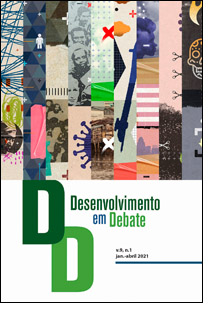O índice de progresso social dos munícipios de Santa Catarina (2010-2017)
Mots-clés :
Santa Catarina, capacitações, progresso social, bem-estarRésumé
O artigo segue a visão da avaliação de progresso social centrada nas capacitações das pessoas, medindo o bem-estar dos municípios do estado de Santa Catarina no período 2010-2017. A metodologia utilizada neste trabalho para construir um índice é uma adaptação da abordagem utilizada pelo Social Progress Index (SPI). A primeira conclusão é que parece que o progresso social tem uma relação mais evidente com o Índice de Desenvolvimento Humano (IDH) do que com o PIB per capita.
A segunda conclusão do trabalho é que a maioria dos municípios, mesmo aqueles que ocupam as melhores posições em termos de desenvolvimento social, precisam melhorar pelo menos uma dimensão
do progresso social.A terceira conclusão é que os municípios com menor índice estão, em geral, nas mesorregiões oeste, serrana e parte da mesorregião norte; por outro lado, os municípios com o melhor índice estão localizados no leste do estado de Santa Catarina.
Références
ABDALLAH, S.; THOMPSON, S.; MICHAELSON, J.; MARKS, N. & STEUER, N. The Happy Planet Index 2.0: Why good lives don’t
have to cost the Earth. London: Nef (The New Economics Foundation), 2009.
ALKIRE, S. & FOSTER, J. Counting and multidimensional
poverty. In: BRAUN, J. et al. The poorest and hungry: assessment, analyses, and actions. Washington: International Food Policy Research Institute, 2009.
ALKIRE, S., ROCHE, J.M., SANTOS, M. E. & SETH, S. Multidimensional Poverty Index 2011: Brief Methodological Note. Oxford Poverty & Human Development Initiative (OPHI), 2011.
ANSELIN, L. Local Indicators of Spatial Association — LISA. Geographical Analysis n. 27, pp. 93–115, 1995.
BRAZILIAN INSTITUTE OF GEOGRAPHY AND STATISTICS (IBGE) Cidades, 2018.
COYLE, D. GDP: A Brief but Affectionate History. Princeton: Princeton University Press, 2014.
GONZÁLEZ, E., CÁRCABA, A. VENTURA, J. & GARCIA, J. Measuring quality of life in Spanish municipalities. Local Government
Studies. v. 37, n. 2, 2011.
HAQ, M. Reflections on Human Development. New York: Oxford University Press, 1995.
HASHIMOTO, A. & ISHIKAWA, H. Using DEA to evaluate the state of society as measured by multiple social indicators. Socio
Economic Planning Sciences, n.27, pp. 257- 268, 1993.
MORAES, M. M., MARIN, S. R. & VIEIRA, C.A. Pobreza multidimensional em Santa Catarina (2000-2010): Uma aplicação do método Alkire-Foster. Economia e Desenvolvimento, v. 7, n. 30, nov. 2018.
NUSSBAUM, M. C. Women and human development: The capabilities approach. New York: Cambridge University Press, 2000.
PONTES, H. M. M. IBGE – Agência de Notícias. IBGE - Agência de Notícias, 2017.
PULICI, A., CARVALHO MOURA, D. & MOSANER, M. Índice de Progresso Social no Rio de Janeiro 2016. Social Progress Imperative, 2017.
RANIS, G. & STEWARD, F. Dynamic Links between economic growths and Human Development. DESA Working Paper, n.8,
SANTOS, D., MOSANER, M., CELENTANO, D., MOURA R. & VERÍSSIMO, A. Índice de Progresso Social na Amazônia brasileira: IPS Amazônia 2018. Belém, PA: Imazon; Social Progress Imperative, 2018.
SEN, A. K. Choice, welfare, and measurement. Oxford: Basil Blackwell, 1982.
SEN, A. Desigualdade reexaminada. Rio de Janeiro: Record, 1992.
STIGLITZ, J. E., FITOUSSI, J.P., & DURAND, M. Beyond GDP: Measuring What Counts for Economic and Social Performance. Paris: OECD Publishing, 2018.
STREETEN, P. Human Development: Means and Ends. Human Development. v.84, n.2, p.232-237, 1994. UNDP. Human Development Report 2016. Technical notes, 2016.

